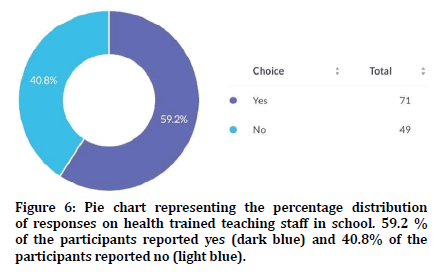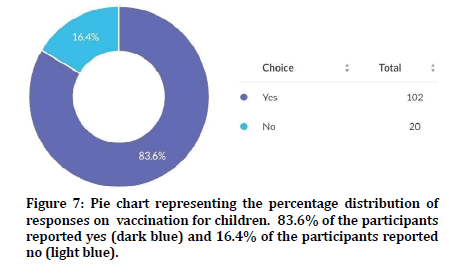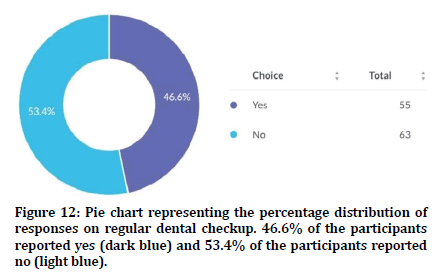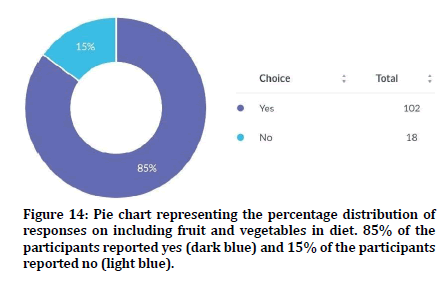Research - (2021) Volume 9, Issue 1
Awareness on Health Checkup for School Students Among Parents
Ngoubinah pretty TM, Vishnu Priya V* and Gayathri R
*Correspondence: Vishnu Priya V, Department of Biochemistry, Saveetha Dental College and Hospital, Saveetha Institute of Medical and Technical Sciences (SIMATS), Saveetha University Tamilnadu, India, Email:
Abstract
Health is a state of complete physical, mental and social wellbeing and not merely the absence of diseases. Health practices create a preventive barrier thus promotes and establishes a sound health check-up status of a child’s psychological characteristics such as optimism, self-control, confidence, and can also have a positive effect on both physical and mental health throughout life. Given the current high incidence of infectious diseases among primary, junior, and senior high school students, it is very important to improve the knowledge of students and parents on infectious diseases which serves as an important channel in controlling epidemics and outbreaks of infectious diseases in schools. The aim of the study is to create awareness on health checkup for school students among parents. Self-administered questionnaire was designed based on knowledge, attitude, perception and practice and was distributed to parents through an online survey planet link. The questions were distributed among 124 parents and the data was collected and systematically analyzed. In the present survey, we found that the majority of participants took their children for frequent health checkups, and were aware about the importance of their children's health. Hence it is important to take frequent health checks to maintain good health and prevent them from contagious disease. Health checkup camps in schools and colleges, seminars, workshops may be conducted to create awareness on regular health checkup for children among parents.
Keywords
Health checkup, Survey planet, Online survey, Health literacy
Introduction
To reduce the global burden of oral disorders the world health organization recommends oral health promotions at the school level to develop the knowledge, attitude and behavior related to oral health programs [1]. Many school-aged children in our countries are affected by treatable and preventable illness, school children’s ill health can be associated with poor cognitive development, learning, academic performance. Introducing the concept of health-promoting school which can be characterized as schools seeking to strengthen their capacity and enable a healthy environment in school [2].
Many oral health programs are preventable and reversible at their early onset. In several countries a considerable number of children, their parents and teachers have limited knowledge of causes and prevention of oral diseases. Improper feeding practice, nutritive or nonnutritive, are not the major culprits in causing early childhood caries but also affect the occlusive development and the growth of jaws. Muscular activity plays an important role in infant survival. Dental fluorosis not only poses an aesthetic and psychological problem but also predisposes to dental caries [3]. There is no study among the south Indian population. School health services provide an excellent opportunity for detection and treatments of children and young people at risk of later health problems, health education could provide individuals with the necessary knowledge, skills and motivation to make healthier life choices. Health education programs are expected to improve the outcome of pre-marital screening programs by rinsing awareness and understanding of the hereditary nature of sickle cell anemia and its association complication [3,4].
Health problems would provide individuals with the necessary knowledge, skills and motivation to make healthier life choices. Physical education is incorporated in this framework as an essential pillar with the goal of providing a rich learning opportunity to all students so they acquire the knowledge, skills and disposition [5]. Previous study on cancer biology, Nano materials, herbal products [5-10], has motivation to pursue this current research which is useful to our community. The aim of this study is to create awareness on health check-up for school students among parents.
Materials and Methods
Self-administered questionnaires were designed and distributed through an online survey link. The study population included 124 parents. The participants were explained about the purpose of the study in detail. The study was approved by the Institutional Review Board, Saveetha Dental College. The questions were carefully studied and the corresponding answers were marked by the participants. The data was collected and statistically analyzed.
Results and Discussion
68% of the parents took their children for regular check-up and 32% did not take their children for a regular check-up (Figure 1). 57% of the parents took their children for health checkup once in six months and 43% of the parents does not take their children for a health check-up once in six months (Figure 2). 76% of the parents felt that the children had physical activity and 24% of the parents felt that the children did not do physical activity (Figure 3). 73.9% of the parents agreed that children fell sick often and 26.1% disagreed (Figure 4). 57.2% of the parents agreed that the schools conducted special health programs in their school and 44.8% of the parents agreed that schools do not conduct special health programs (Figure 5).

Figure 1. Pie chart representing the percentage distribution of responses on regular check-up for children. 68% of the participants reported yes (dark blue) and 32% of the participants reported no (light blue).

Figure 2. Pie chart representing the percentage distribution of responses on health check-up for children once in six months. 57 % of the participants reported yes (dark blue) and 43% of the participants reported no (light blue).

Figure 3. Pie chart representing the percentage distribution of responses on physical activity for children. 76% of the participants reported yes (dark blue) and 24% of the participants reported no (light blue).

Figure 4. Pie chart representing the percentage distribution of responses on children falling sick often. 26% of the participants reported yes (dark blue) and 73% of the participants reported no (light blue).

Figure 5. Pie chart representing the percentage distribution of responses on special health programs in children school. 55.2% of the participants reported yes (dark blue) and 44.8% of the participants reported no (light blue).
59.2% of parents agreed that schools had health care workers and 40.8% of parents agreed that schools do not have health care workers (Figure 6). 83.6% of the parents took their children for the vaccine and 16.4% did not take their children for the vaccine (Figure 7). 95.9% of parents encourage their children in other curricular activities and 4.1% did not encourage their children in other activities (Figure 8). 77.3% of the parents said that the BMI of children were normal and 22.7% of parents said that the BMI of children was not normal (Figure 9). 69.5% of parents felt that children were not obese and 30.5% agreed that children were obese (Figure 10). 55.8% of parents felt that children consumed junk food often 44.2% of parents felt that children did not consume junk food (Figure 11). 53.4% of the parents did not take their children for regular dental check-up and 46.6% of the parents took their children for a regular dental check-up (Figure 12). 48.3% of the parents said that children drank 3 litres of water a day and 51.7% of the parents said that children did not drink 3 liters of water per day (Figure 13). 85% of the parents included fruits and vegetables in their children's diet and 15% of the parents did not include fruits and vegetables in their diet (Figure 14). 26.1% of the parents agreed that they had a genetic disorder in their family and 73.9% of parents agreed that they did not have genetic disorder in their family (Figure 15).

Figure 6. Pie chart representing the percentage distribution of responses on health trained teaching staff in school. 59.2 % of the participants reported yes (dark blue) and 40.8% of the participants reported no (light blue).

Figure 7. Pie chart representing the percentage distribution of responses on vaccination for children. 83.6% of the participants reported yes (dark blue) and 16.4% of the participants reported no (light blue).

Figure 8. Pie chart representing the percentage distribution of responses on encouraging children in other curricular activities. 95.9% of the participants reported yes (dark blue) and 5% of the participants reported no (light blue).

Figure 9. Pie chart representing the percentage distribution of responses on normal BMI. 77.3% of the participants reported yes (dark blue) and 22.7% of the participants reported no (light blue).

Figure 10. Pie chart representing the percentage distribution of responses on juvenile obesity. 30.5% of the participants reported yes (dark blue) and 69.5% of the participants reported no (light blue).

Figure 11. Pie chart representing the percentage distribution of responses on consuming junk food often. 55.8% of the participants reported yes (dark blue) and 44.2% of the participants reported no (light blue).

Figure 12. Pie chart representing the percentage distribution of responses on regular dental checkup. 46.6% of the participants reported yes (dark blue) and 53.4% of the participants reported no (light blue).

Figure 13. Pie chart representing the percentage distribution of responses on drinking 3 liter of water per day. 48.3% of the participants reported yes (dark blue) and 51.7% of the participants reported no (light blue).

Figure 14. Pie chart representing the percentage distribution of responses on including fruit and vegetables in diet. 85% of the participants reported yes (dark blue) and 15% of the participants reported no (light blue).

Figure 15. Pie chart representing the percentage distribution of responses on genetic disorder in your family. 26.1% of the participants reported yes (dark blue) and 73.9% of the participants reported no (light blue).
Majority of the children suffered from toothache problems in spite of regular brushing habits. Parents lack awareness regarding preventive measures and dental visit [1]. In a similar article, the author concluded their findings highlighted that stakeholder from all should coordinate and continue their efforts to effective implementation and continue their efforts to effectively implement and expand the programs nationwide [2]. In this study, the author concluded that when school children maintain good oral health then their confidence level also increases. Since children are often the most important victim of dental disease, good oral hygiene should be maintained [3]. In the recent article the author made the parents, nurse and teachers fill a study questionnaire response, which is similar to this study, to find a potential concern about each child before the health checkup they concluded that their study increases their knowledge of the benefits of school doctors routine health checkup and assesses the develop screening method [4].
In a previous study the author concluded that there is no significant difference in response to attitude before and after the health education interventions [11]. In a study the author concluded that health education contributes to student knowledge and behavior towards infection disorders. Health education needs to pay particular attention to rural students, all male students and students at senior higher school level living on campus [11,12]. In a similar study, the author aims to analyze the relationship between parents and physical education students and the importance they give to physical education within the curriculum. The author also concluded that parents' interactions can be useful to increase parents' awareness of the current standard for quality and the role that physical education can play in promoting the lifestyle. Further research should explore if the kind of interventions could reverse parents' lack of knowledge or misconception and bad past experience [13].
In a study, the author concluded that low awareness level was found towards infant oral health care but a positive attitude among mothers; hence it is a suggestion to increase this dental health checkup for themselves and their children by educating and motivating the mothers [14]. In a similar study the author conducted a questionnaire based survey in the district hospital of Srinagar, Kashmir. The author concluded that educating mothers on child dental care will promote lifelong good oral hygiene and will bring down the prevalence of oral disease considerably [15].
Conclusion
According to this study there was awareness of health checkup for school students among parents and taking children for regular checkup is a mandatory job of a parent to maintain their health and prevent them from contagious disease. Health checkup camps in schools and colleges, seminars, workshops may be conducted to create awareness on regular health checkup for children among parents.
Acknowledgment
We thank Saveetha Dental College for providing us the support to conduct the study.
Conflict of Interest
Nil.
References
- Mishra A, Pandey RK, Chopra H, et al. Oral health awareness in school-going children and its significance to parent's education level. J Indian Soc Pedod Prev Dent 2018; 36:120.
- Shrestha RM, Ghimire M, Shakya P, et al. School health and nutrition program implementation, impact, and challenges in schools of Nepal: stakeholders’ perceptions. Trop Med Healt 2019; 47:1-1.
- Parmar P, Radha G, Rekha R, et al. Promoting oral hygiene and health through school. International J Oral Health Sci 2016; 6:70.
- Nikander K, Kosola S, Kaila M, et al. Who benefit from school doctors’ health checks: a prospective study of a screening method. BMC Health Serv Res 2018; 18:501.
- Ponnulakshmi R, Shyamaladevi B, Vijayalakshmi P, et al. In silico and in vivo analysis to identify the antidiabetic activity of beta sitosterol in adipose tissue of high fat diet and sucrose induced type-2 diabetic experimental rats. Toxicol Mech Methods 2019; 29:276-290.
- Wu F, Zhu J, Li G, et al. Biologically synthesized green gold nanoparticles from Siberian ginseng induce growth-inhibitory effect on melanoma cells (B16). Artif Cells Nanomed Biotechnol 2019; 47:3297-3305.
- Ke Y, Al Aboody MS, Alturaiki W, et al. Photosynthesized gold nanoparticles from Catharanthus roseus induces caspase-mediated apoptosis in cervical cancer cells (HeLa). Artif Cells Nanomed Biotechnol 2019; 47:1938-1946.
- Ma Y, Karunakaran T, Veeraraghavan VP, et al. Sesame inhibits cell proliferation and induces apoptosis through inhibition of STAT-3 translocation in thyroid cancer cell lines (FTC-133). Biotechnol Bioprocess Eng 2019; 24:646-652.
- Li Z, Veeraraghavan VP, Mohan SK, et al. Apoptotic induction and anti-metastatic activity of eugenol encapsulated chitosan nanopolymer on rat glioma C6 cells via alleviating the MMP signaling pathway. J Photochem Photobiol B 2020; 203:111773.
- Chen F, Tang Y, Sun Y, et al. 6-shogaol, a active constiuents of ginger prevents UVB radiation mediated inflammation and oxidative stress through modulating NrF2 signaling in human epidermal keratinocytes (HaCaT cells). J Photochem Photobiol B. 2019; 197:111518.
- Kotb MM, Almalki MJ, Hassan Y, et al. Effect of Health Education Programme on the Knowledge of and Attitude about Sickle Cell Anaemia among Male Secondary School Students in the Jazan Region of Saudi Arabia: Health Policy Implications. Biomed Res Int 2019; 2019.
- Wang M, Han X, Fang H, et al. Impact of health education on knowledge and behaviors toward infectious diseases among students in Gansu Province, China. Biomed Res Int 2018; 2018.
- Lago-Ballesteros J, Martins J, González-Valeiro MÁ, et al. Parental assessment of physical education in the school curriculum: A brief report on the influence of past experiences as students. PloS one 2019; 14:e0219544.
- Jindal A, Namdev R, Aggarwal G, et al. Attitude and awareness of expectant and lactating mothers toward infant oral health care in North Indian subpopulation: A cross-sectional study. Saudi J Oral Sci 2018; 5:28.
- Gambhir RS, Anand S, Gupta T, et al. Knowledge and awareness regarding oral health among anganwadi workers in India: A systematic review. J Indian Assoc Public Health Dent 2016; 14:231.
Author Info
Ngoubinah pretty TM, Vishnu Priya V* and Gayathri R
Department of Biochemistry, Saveetha Dental College and Hospital, Saveetha Institute of Medical and Technical Sciences (SIMATS), Saveetha University Tamilnadu, Chennai, IndiaCitation: Ngoubinah pretty TM, Vishnu Priya V, Gayathri R, Awareness on Health Checkup for School Students among Parents, J Res Med Dent Sci, 2021, 9 (1): 314-318.
Received: 23-Sep-2020 Accepted: 08-Jan-2021
